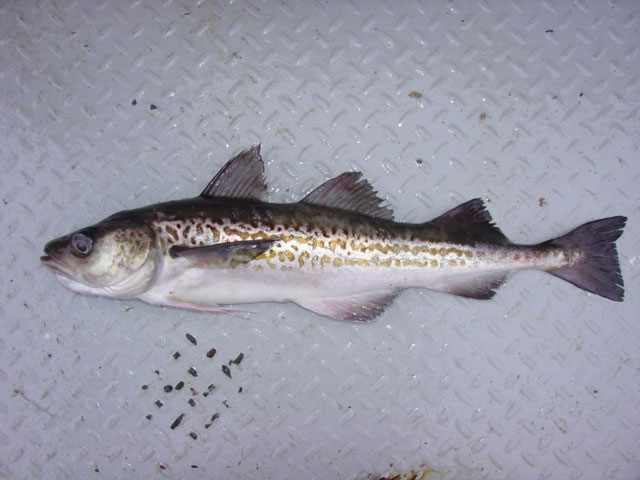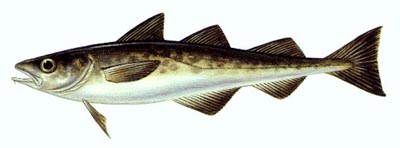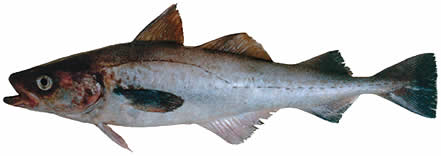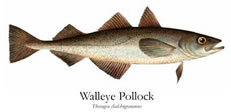
Theragra chalcogramma
FAMILY
Gadidae
TAXONOMY
Theragra chalcogramma Pallas, 1811, sea of Okhotsk and the
shores of Kamchatka.
OTHER COMMON NAMES
English: Walleye pollock.
PHYSICAL CHARACTERISTICS
Three separate dorsal fins, two separate anal fins. Dorsal and
anal fins separated by gaps. A very tiny chin barbel present.
Pelvic fins sometimes with one ray elongate. Olive green to
brown dorsally, silvery on sides, pale ventrally. Often mottled
or blotchy.
DISTRIBUTION
Found in temperate and subarctic waters of the Northern Pacific
Ocean from Sea of Japan, through Okhotsk Sea, Bering
Sea, and Gulf of Alaska, then south to waters off central California.
Separate stocks (as many as 12) occur in the North Pacific,
including those in the Gulf of Alaska, Aleutian Islands,
and Bering Sea.
HABITAT
A schooling fish found on or near the bottom, but also in midwater
to near-surface depths. Heaviest catches made at depths
between 164 and 984 ft (50 and 300 m).
BEHAVIOR
Alaska pollock perform vertical migrations on a daily basis.
Juveniles ascend at night to feed on zooplankton near the
surface. Migrations of the entire population associated with
spawning and feeding. Alaska pollock follow a circular pattern
of migrations in the Bering Sea, moving inshore in the spring
to spawn and feed, and offshore to warmer, deeper waters in
winter.
FEEDING ECOLOGY AND DIET
Young fish feed on copepod adults and eggs. Adults prey on
shrimps, sand lance, and herring off British Columbia; on pink,
chum, and coho salmon in Alaskan waters; on mysids, euphausiids,
silver smelt, and capelin in Asian waters.
REPRODUCTIVE BIOLOGY
Alaska pollock begin spawning at age two, but ages four and
five contribute most to reproduction. Most spawning begins
late February in the Bering Sea, March or April in the Gulf of
Alaska. Major spawning aggregations are found in Shelikof
Strait, Straits of Georgia, Aleutian Basin, and off the Pribilof
Islands. Spawning fish form dense schools high in the water
column. Fecundity ranges from 37,000 eggs per female to
nearly one million off the coast of Canada. In the western
Bering Sea, an 11-year-old female can produce 15 million eggs.
Eggs are pelagic and occur mostly within 98 ft (30 m) of the
surface.
CONSERVATION STATUS
Not listed by the IUCN. Based on estimates of spawning stock
biomass and projections into the near future, the Gulf of
Alaska stock is not in an overfished condition, nor is it predicted
to be.
SIGNIFICANCE TO HUMANS
The Alaska pollock has become an increasingly important human
food resource. In the early 1990s, landings of this species
were the largest of any demersal fish. The FAO Yearbook of
Fishery Statistics for 1987 reported 7,389,750 tn (6,703,868 t)
were landed, primarily in the western part of the North
Pacific by USSR, Japan, Poland, and Republic of Korea. The
largest catches are made over the outer shelf and slope of
the eastern Bering Sea, between the Aleutian Islands and the
Pribilofs.
Photo Gallery of - Alaska pollock





 Animalia Life
Animalia Life